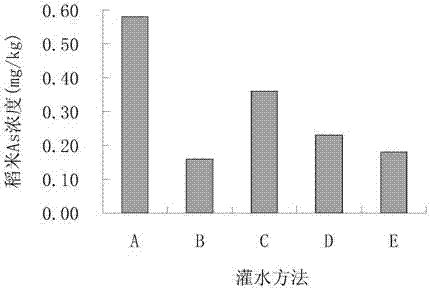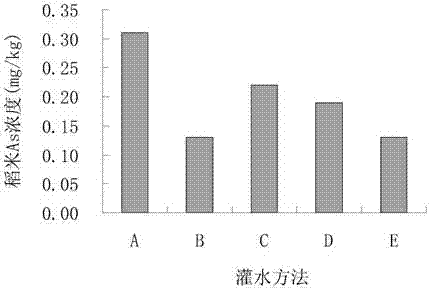Irrigation method for reducing arsenic concentration of rice in fields with severe arsenic pollution
A technology for arsenic pollution and paddy fields, applied in botany equipment and methods, rice cultivation, watering devices, etc., can solve the problems of rice yield decline, toxic and harmful substances increase rice absorption, lack of scientificity, etc., and achieve the goal of reducing arsenic concentration Effect
- Summary
- Abstract
- Description
- Claims
- Application Information
AI Technical Summary
Problems solved by technology
Method used
Image
Examples
Embodiment 1
[0020] Example 1: An irrigation method for reducing rice arsenic concentration in heavily arsenic-contaminated paddy fields. In rice production, water is lightly controlled from the tillering stage to the heading stage and the 21st day after heading to the mature stage, and flood irrigation in other periods , keep the water layer 3-5cm; the degree of water control is mild water control, from the appearance of the soil, the topsoil begins to harden, but it is not whitish, and fine cracks appear. If the soil water content is measured, keep the soil water content at 80% ± 5% of the maximum water holding capacity. Compared with the flood irrigation during the whole growth period of rice commonly used in production, the rice yield did not decrease significantly (the decline rate was less than 3%), but the arsenic concentration of rice decreased by 58%-69% (see figure 1 , figure 2 ).
[0021] The rice grows to the tillering stage (generally about 40 days after transplanting, the ...
PUM
 Login to View More
Login to View More Abstract
Description
Claims
Application Information
 Login to View More
Login to View More - R&D
- Intellectual Property
- Life Sciences
- Materials
- Tech Scout
- Unparalleled Data Quality
- Higher Quality Content
- 60% Fewer Hallucinations
Browse by: Latest US Patents, China's latest patents, Technical Efficacy Thesaurus, Application Domain, Technology Topic, Popular Technical Reports.
© 2025 PatSnap. All rights reserved.Legal|Privacy policy|Modern Slavery Act Transparency Statement|Sitemap|About US| Contact US: help@patsnap.com


